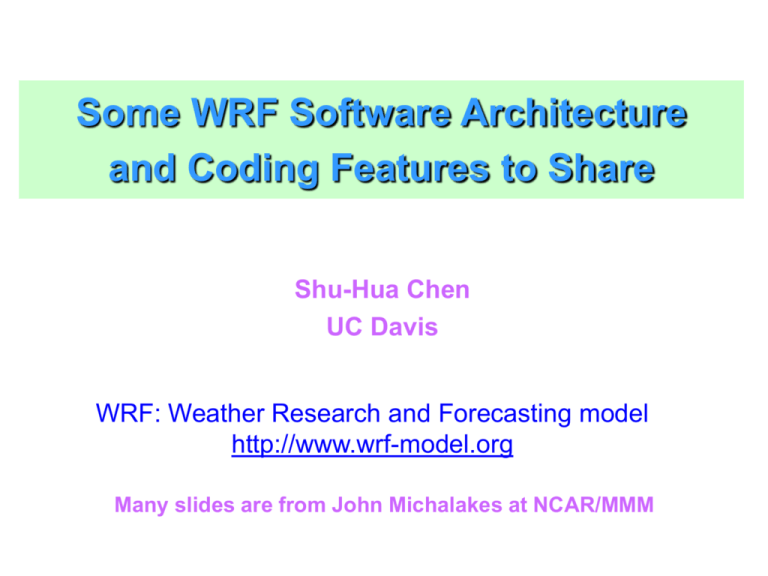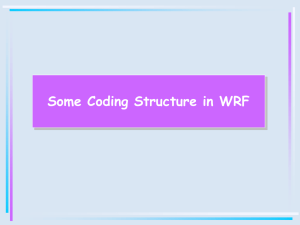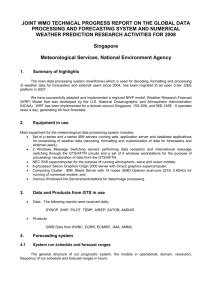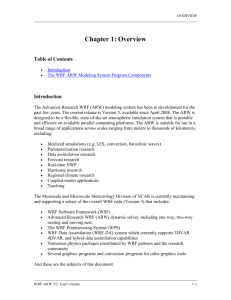nchc_2008 - MMG @ UCD: Research
advertisement

Some WRF Software Architecture and Coding Features to Share Shu-Hua Chen UC Davis WRF: Weather Research and Forecasting model http://www.wrf-model.org Many slides are from John Michalakes at NCAR/MMM Motivation of this talk To develop a new hydro-meteorological community model, we need a well-designed software architecture to: • Communicate easily • Reduce coding error • increase coding efficiency • Expand easily So, we need a software architecture team Modeling and software architecture teams have to work closely Share some WRF software architecture and coding features with the group Some WRF Software Architecture and Coding Features C++ & F90 w/ structure and dynamic memory allocation Run-time configuration Multi-level parallel decomposition shared-, distributed-, hybrid-memory Hierarchical software design Data structure Registry Time management and error handling Physics coding structure Storm braining & wishing list Some WRF Software Architecture and Coding Features C++ & F90 w/ structure and dynamic memory allocation Run-time configuration Multi-level parallel decomposition shared-, distributed-, hybrid-memory Hierarchical software design Data structure Registry Time management and error handling Physics coding structure Storm braining & wishing list Some WRF Software Architecture and Coding Features C++ & F90 w/ structure and dynamic memory allocation Run-time configuration Multi-level parallel decomposition shared-, distributed-, hybrid-memory Hierarchical software design Data structure Registry Time management and error handling Physics coding structure Storm braining & wishing list Some WRF Software Architecture and Coding Features C++ & F90 w/ structure and dynamic memory allocation Run-time configuration Multi-level parallel decomposition shared-, distributed-, hybrid-memory Hierarchical software design Data structure Registry Time management and error handling Physics coding structure Storm braining & wishing list Multi-level parallel decomposition Logical domain 1 Patch, divided into multiple tiles • Single version of code for efficient execution on: – Distributed-memory – Shared-memory – Hybrid-memory Model domains are decomposed for parallelism on two-levels Patch: section of model domain allocated to a distributed memory node Tile: section of a patch allocated to a shared-memory processor within a node; this is also the scope of a model layer subroutine. Distributed memory parallelism is over patches; shared memory parallelism is over tiles within patches Multi-level parallel decomposition Three Sets of Dimensions used in subroutines Domain size: ids, ide, jds, jde, kds, kde Memory size: ims, ime, jms, jme, kms, kme Tile size: its, ite, jts, jte, kts, kte template for model layer subroutine SUBROUTINE model ( & arg1, arg2, arg3, … ids, ide, jds, jde, ims, ime, jms, jme, its, ite, jts, jte, , argn, kds, kde, kms, kme, kts, kte & & & ) ! Domain dims ! Memory dims ! Tile dims IMPLICIT NONE ! Define Arguments (S and I1) data REAL, DIMENSION (ims:ime,kms:kme,jms:jme) :: arg1, . . . REAL, DIMENSION (ims:ime,jms:jme) :: arg7, . . . . . . ! Define Local Data (I2) REAL, DIMENSION (its:ite,kts:kte,jts:jte) :: loc1, . . . . . . ! Executable code; loops run over tile ! dimensions DO j = jts, jte DO k = kts, kte DO i = MAX(its,ids), MIN(ite,ide) loc(i,k,j) = arg1(i,k,j) + … END DO END DO END DO • Domain dimensions • Size of logical domain • Used for bdy tests, etc. template for model layer subroutine SUBROUTINE model ( & arg1, arg2, arg3, … ids, ide, jds, jde, ims, ime, jms, jme, its, ite, jts, jte, , argn, kds, kde, kms, kme, kts, kte & & & ) • Domain dimensions • Size of logical domain • Used for bdy tests, etc. ! Domain dims ! Memory dims ! Tile dims IMPLICIT NONE ! Define Arguments (S and I1) data REAL, DIMENSION (ims:ime,kms:kme,jms:jme) :: arg1, . . . REAL, DIMENSION (ims:ime,jms:jme) :: arg7, . . . . . . ! Define Local Data (I2) REAL, DIMENSION (its:ite,kts:kte,jts:jte) :: loc1, . . . . . . ! Executable code; loops run over tile ! dimensions DO j = jts, jte DO k = kts, kte DO i = MAX(its,ids), MIN(ite,ide) loc(i,k,j) = arg1(i,k,j) + … END DO END DO END DO logical patch Distributed Memory Communications Example code fragment that requires communication between patches Note the tell-tale +1 and –1 expressions in indices for rr and H1 arrays on right-hand side of assignment. These are horizontal data dependencies because the indexed operands may lie in the patch of a neighboring processor. That neighbor’s updates to that element of the array won’t be seen on this processor. We have to communicate. (dyn_eh/module_diffusion.F ) SUBROUTINE horizontal_diffusion_s (tendency, rr, var, . . . . . . DO j = jts,jte DO k = kts,ktf DO i = its,ite mrdx=msft(i,j)*rdx mrdy=msft(i,j)*rdy tendency(i,k,j)=tendency(i,k,j)(mrdx*0.5*((rr(i+1,k,j)+rr(i,k,j))*H1(i+1,k,j)(rr(i-1,k,j)+rr(i,k,j))*H1(i ,k,j))+ mrdy*0.5*((rr(i,k,j+1)+rr(i,k,j))*H2(i,k,j+1)(rr(i,k,j-1)+rr(i,k,j))*H2(i,k,j ))msft(i,j)*(H1avg(i,k+1,j)-H1avg(i,k,j)+ H2avg(i,k+1,j)-H2avg(i,k,j) )/dzetaw(k) ) ENDDO ENDDO ENDDO . . . & & & & & & & & template for model layer subroutine SUBROUTINE model ( & arg1, arg2, arg3, … ids, ide, jds, jde, ims, ime, jms, jme, its, ite, jts, jte, , argn, kds, kde, kms, kme, kts, kte & & & ) • Domain dimensions • Size of logical domain • Used for bdy tests, etc. ! Domain dims ! Memory dims ! Tile dims IMPLICIT NONE ! Define Arguments (S and I1) data REAL, DIMENSION (ims:ime,kms:kme,jms:jme) :: arg1, . . . REAL, DIMENSION (ims:ime,jms:jme) :: arg7, . . . . . . ! Define Local Data (I2) REAL, DIMENSION (its:ite,kts:kte,jts:jte) :: loc1, . . . . . . ! Executable code; loops run over tile ! dimensions DO j = jts, jte DO k = kts, kte DO i = MAX(its,ids), MIN(ite,ide) loc(i,k,j) = arg1(i,k,j) + … END DO END DO END DO logical patch • template for model layer subroutine SUBROUTINE model ( & arg1, arg2, arg3, … ids, ide, jds, jde, ims, ime, jms, jme, its, ite, jts, jte, , argn, kds, kde, kms, kme, kts, kte & & & ) • ! Domain dims ! Memory dims ! Tile dims IMPLICIT NONE ! Define Arguments (S and I1) data REAL, DIMENSION (ims:ime,kms:kme,jms:jme) :: arg1, . . . REAL, DIMENSION (ims:ime,jms:jme) :: arg7, . . . . . . ! Define Local Data (I2) REAL, DIMENSION (its:ite,kts:kte,jts:jte) :: loc1, . . . . . . ! Executable code; loops run over tile ! dimensions DO j = jts, jte DO k = kts, kte DO i = MAX(its,ids), MIN(ite,ide) loc(i,k,j) = arg1(i,k,j) + … END DO END DO END DO Domain dimensions • Size of logical domain • Used for bdy tests, etc. Memory dimensions • Used to dimension dummy arguments • Do not use for local arrays jme 1 node logical patch halo ims ime jms • template for model layer subroutine SUBROUTINE model ( & arg1, arg2, arg3, … ids, ide, jds, jde, ims, ime, jms, jme, its, ite, jts, jte, , argn, kds, kde, kms, kme, kts, kte & & & ) • ! Domain dims ! Memory dims ! Tile dims IMPLICIT NONE ! Define Arguments (S and I1) data REAL, DIMENSION (ims:ime,kms:kme,jms:jme) :: arg1, . . . REAL, DIMENSION (ims:ime,jms:jme) :: arg7, . . . . . . ! Define Local Data (I2) REAL, DIMENSION (its:ite,kts:kte,jts:jte) :: loc1, . . . . . . ! Executable code; loops run over tile ! dimensions DO j = jts, jte DO k = kts, kte DO i = MAX(its,ids), MIN(ite,ide) loc(i,k,j) = arg1(i,k,j) + … END DO END DO END DO • Domain dimensions • Size of logical domain • Used for bdy tests, etc. Memory dimensions • Used to dimension dummy arguments • Do not use for local arrays Tile dimensions • Local loop ranges • Local array dimensions jme jte tile its jts ite halo ims ime jms Some WRF Software Architecture and Coding Features C++ & F90 w/ structure and dynamic memory allocation Run-time configuration Multi-level parallel decomposition shared-, distributed-, hybrid-memory Hierarchical software design Data structure Registry Time management and error handling Physics coding structure Storm braining & wishing list Hierarchical software design Driver Layer Mediation Layer Model Layer • Hierarchical software architecture – Insulate scientists' code from parallelism and other architecture/implementation-specific details – Well-defined interfaces between layers, and external packages for communications, I/O, and model coupling facilitates code reuse and exploiting of community infrastructure, e.g., ESMF. Hierarchical software design Driver Layer Mediation Layer Model Layer • Driver Layer – Allocates, stores, decomposes model domains, represented abstractly as single data objects – Contains top-level time loop and algorithms for integration over nest hierarchy – Contains the calls to I/O, nest forcing and feedback routines supplied by the Mediation Layer – Provides top-level, non package-specific access to communications, I/O, etc. – Provides some utilities, for example module_wrf_error, which is used for diagnostic prints and error stops Hierarchical software design Driver Layer Mediation Layer Model Layer • Mediation Layer – Provides to the Driver layer • Solve solve routine, which takes a domain object and advances it one time step • I/O routines to Driver when it is time to do some input or output operation on a domain • Nest forcing and feedback routines • The Mediation Layer, not the Driver, knows the specifics of what needs to be done – The sequence of calls to Model Layer routines for doing a time-step is known in Solve routine – Responsible for dereferencing driver layer data objects so that individual fields can be passed to Model layer Subroutines – Calls to message-passing are contained here as part of solve routine123 Hierarchical software design Driver Layer Mediation Layer Model Layer • Model Layer – Contains the information about the model itself, with machine architecture and implementation aspects abstracted out and moved into layers above – Contains the actual WRF model routines that are written to perform some computation over an arbitrarily sized/shaped subdomain – All state data objects are simple types, passed in through argument list – Model Layer routines don’t know anything about communication or I/O; and they are designed to be executed safely on one thread – they never contain a PRINT, WRITE, or STOP statement – These are written to conform to the Model Layer Subroutine Interface which makes them “tile-callable” Directory structure driver mediation model page 5, WRF D&I Document Hierarchical software design Registry wrf Driver Driver Layer integrate (frame/module_integrate.F) Solve solve_em (dyn_em/solve_em.F) Config Model Layer Module DM comm solve_interface (share/solve_interface.F) I/O API OMP Message Passing Config Inquiry Threads Mediation Layer (main/wrf.F) WRF Tile-callable Subroutines advance_uv (dyn_em/module_small_step_em.F) Package Independent Data formats, Package Parallel I/O advance_uv (dyn_em/module_small_step_em.F) advance_uv (dyn_em/module_small_step_em.F) advance_uv (dyn_em/module_small_step_em.F) advance_uv (dyn_em/module_small_step_em.F) cumulus_driver (physics/cumulus_driver.F) External Packages Dependent Some WRF Software Architecture and Coding Features C++ & F90 w/ structure and dynamic memory allocation Run-time configuration Multi-level parallel decomposition shared-, distributed-, hybrid-memory Hierarchical software design Data structure Registry Time management and error handling Physics coding structure Storm braining & wishing list Data structure • WRF Data Taxonomy – State data – Intermediate data type 1 (L1) – Intermediate data type 2 (L2) Data structure State data • Persist for the duration of a domain • Represented as fields in domain data structure • Arrays are represented as dynamically allocated pointer arrays in the domain data structure • Declared in Registry using state keyword • Always memory dimensioned; always thread shared • Only state arrays can be subject to I/O and Interprocessor communication • template for model layer subroutine SUBROUTINE model ( & arg1, arg2, arg3, … ids, ide, jds, jde, ims, ime, jms, jme, its, ite, jts, jte, , argn, kds, kde, kms, kme, kts, kte & & & ) • ! Domain dims ! Memory dims ! Tile dims IMPLICIT NONE ! Define Arguments (S and I1) data REAL, DIMENSION (ims:ime,kms:kme,jms:jme) :: arg1, . . . REAL, DIMENSION (ims:ime,jms:jme) :: arg7, . . . . . . ! Define Local Data (I2) REAL, DIMENSION (its:ite,kts:kte,jts:jte) :: loc1, . . . . . . ! Executable code; loops run over tile ! dimensions DO j = jts, jte DO k = kts, kte DO i = MAX(its,ids), MIN(ite,ide) loc(i,k,j) = arg1(i,k,j) + … END DO END DO END DO Domain dimensions • Size of logical domain • Used for bdy tests, etc. Memory dimensions • Used to dimension dummy arguments • Do not use for local arrays jme 1 node logical patch halo ims ime jms Data structure WRF state variables • May be 0d, 1d, 2d, 3d, or 4d • What they look like in the code: [grid%[core_ ]] var [_tl] integer time level number (if multi-time level variable) name of variable (0- through 3-D); name of 4D array (4D only) core-association if given in Registry (use field starts with "dyn_") when seen in the driver layer (above solve_interface.F) Data structure Example The second time level of the u variable in the Eulerian Mass (EM) core can be accessed in the driver layer as: grid%em_u_2 in the solve_em routine and below it is simply: u_2 Data structure L1 Data • Data that persists for the duration of 1 time step on a domain and then released • Declared in Registry using i1 keyword • Typically automatic storage (program stack) in solve routine • Typical usage is for tendency or temporary arrays in solver • Always memory dimensioned and thread shared • Typically not communicated or I/O Data structure L2 Data • L2 data are local arrays that exist only in model-layer subroutines and exist only for the duration of the call to the subroutine • L2 data is not declared in Registry, never communicated and never input or output • L2 data is tile dimensioned and thread local; overdimensioning within the routine for redundant computation is allowed – the responsibility of the model layer programmer – should always be limited to thread-local data • template for model layer subroutine SUBROUTINE model ( & arg1, arg2, arg3, … ids, ide, jds, jde, ims, ime, jms, jme, its, ite, jts, jte, , argn, kds, kde, kms, kme, kts, kte & & & ) • ! Domain dims ! Memory dims ! Tile dims IMPLICIT NONE ! Define Arguments (S and I1) data REAL, DIMENSION (ims:ime,kms:kme,jms:jme) :: arg1, . . . REAL, DIMENSION (ims:ime,jms:jme) :: arg7, . . . . . . ! Define Local Data (I2) REAL, DIMENSION (its:ite,kts:kte,jts:jte) :: loc1, . . . . . . ! Executable code; loops run over tile ! dimensions DO j = jts, jte DO k = kts, kte DO i = MAX(its,ids), MIN(ite,ide) loc(i,k,j) = arg1(i,k,j) + … END DO END DO END DO • Domain dimensions • Size of logical domain • Used for bdy tests, etc. Memory dimensions • Used to dimension dummy arguments • Do not use for local arrays Tile dimensions • Local loop ranges • Local array dimensions jme jte tile its jts ite halo ims ime jms Data structure • What you see depends on where you are – Driver layer • All data for a domain is a single object, a domain derived data type (DDT) • The domain DDTs are dynamically allocated/deallocated • Linked together in a tree to represent nest hierarchy; root pointer is head_grid, defined in frame/module_domain.F • Supports recursive depth-first traversal algorithm (frame/module_integrate.F) 1 head_grid 2 1 3 4 2 3 4 Data structure • What you see depends on where you are – Driver layer • All data for a domain is a single object, a domain derived data type (DDT) • The domain DDTs are dynamically allocated/deallocated • Linked together in a tree to represent nest hierarchy; root pointer is head_grid, defined in frame/module_domain.F • Supports recursive depth-first traversal algorithm (frame/module_integrate.F) 1 head_grid RECURSIVE SUBROUTINE integrate ( domain , stoptime ) WHILE ( domain.time <= stoptime ) CALL solve ( domain ) ! Advances domain.time 2 3 FOR EACH CHILD OF DOMAIN CALL integrate ( domain.child , domain.time ) 4 Data structure • What you see depends on where you are (Cont.) What you see depends on where you are (Cont.) – Model layer • All data objects are scalars and arrays of simple types only • Virtually all passed in through subroutine argument lists – Mediation layer • One task of mediation layer is to dereference fields from DDTs • Therefore, sees domain data in both forms, as DDT and as individual fields – The name of a data type and how it is referenced may differ depending on the level of the architecture Data structure Lateral B.C. array • State arrays, declared in Registry using the b modifier in the dimension field of the entry • Store specified forcing data on domain 1, or forcing data from parent on a nest • All four boundaries are stored in the array; last index is over: P_XSB (western) P_XEB (eastern) P_YSB (southern) P_YEB (northern) These are defined in module_state_description.F Data structure Lateral B.C. array • LBC arrays are declared as follows: em_u_b(max(ide,jde),kde,spec_bdy_width,4) • Globally dimensioned in first index as the maximum of x and y dimensions • Second index is over vertical dimension • Third index is the width of the boundary (namelist) • Fourth index is which boundary • Note: LBC arrays are globally dimensioned • not fully dimensioned so still scalable in memory • preserves global address space for dealing with LBCs • makes input trivial (just read and broadcast) Data structure Lateral B.C. array unused unused P_YEB jde P_XEB P_XSB A Given Domain jds P_YSB ids ide Data structure Four dimensional tracer arrays • State arrays, used to store arrays of 3D fields such as moisture tracers, chemical species, ensemble members, etc. • First 3 indices are over grid dimensions; last dimension is the tracer index • Each tracer is declared in the Registry as a separate state array but with f and optionally also t modifiers to the dimension field of the entry • The field is then added to the 4D array whose name is given by the use field of the Registry entry 4D array example • 4D moisture field, moist_1(i,k,j,?) ? = P_QV (water vapor) P_QC (cloud water) P_QI (cloud ice) P_QR (rain) P_QS (snow) P_QG (graupel) Data structure Four dimensional tracer arrays • Fields of a 4D array are input and output separately and appear as any other 3D field in a WRF dataset • The extent of the last dimension of a tracer array is from PARAM_FIRST_SCALAR to num_tracername – Both defined in Registry-generated frame/module_state_description.F – PARAM_FIRST_SCALAR is a defined constant (2) – Num_tracername is computed at run-time in set_scalar_indices_from_config (module_configure) – Calculation is based on which of the tracer arrays are associated with which specific packages in the Registry and on which of those packages is active at run time (namelist.input) Example, in Registry # specification of microphysics options package passiveqv mp_physics==0 package kesslerscheme mp_physics==1 package linscheme mp_physics==2 package ncepcloud3 mp_physics==3 package ncepcloud5 mp_physics==4 - moist:qv moist:qv,qc,qr moist:qv,qc,qr,qi,qs,qg moist:qv,qc,qr moist:qv,qc,qr,qi,qs # namelist entry that controls microphysics option rconfig integer mp_physics namelist,namelist_04 max_domains 0 Data structure Four dimensional tracer arrays • Each tracer index (e.g. P_QV) into the 4D array is also defined in module_state_description and set in set_scalar_indices_from_config • Code should always test that a tracer index greater than or equal to PARAM_FIRST_SCALAR before referencing the tracer (inactive tracers have an index of 1) • Loops over tracer indices should always run from PARAM_FIRST_SCALAR to num_tracername -- EXAMPLE 4D array example • 4D moisture field, moist_1(i,k,j,?) ? = P_QV (water vapor) P_QC (cloud water) P_QI (cloud ice) P_QR (rain) P_QS (snow) P_QG (graupel) IF ( P_QI .ge. PARAM_FIRST_SCALAR ) then (the memory of cloud ice is allocated) ... Some WRF Software Architecture and Coding Features C++ & F90 w/ structure and dynamic memory allocation Run-time configuration Multi-level parallel decomposition shared-, distributed-, hybrid-memory Hierarchical software design Data structure Registry Time management and error handling Physics coding structure Storm braining & wishing list The Registry • "Active data-dictionary” for managing WRF data structures – Database describing attributes of model state, intermediate, and configuration data • • • • • Dimensionality, number of time levels, staggering Association with physics I/O classification (history, initial, restart, boundary) Communication points and patterns Configuration lists (e.g. namelists) – Program for auto-generating sections of WRF from database: • • • • • • 570 Registry entries 30-thousand lines of automatically generated WRF code Allocation statements for state data, I1 data Argument lists for driver layer/mediation layer interfaces Interprocessor communications: Halo and periodic boundary updates, transposes Code for defining and managing run-time configuration information Code for forcing, feedback and interpolation of nest data • Automates time consuming, repetitive, error-prone programming • Insulates programmers and code from package dependencies • Allow rapid development • Documents the data Registry Mechanics %compile wrf Registry/Registry CPP ____________ WRF source */*.F registry program: tools/registry inc/*.incl Fortran90 wrf.exe Registry data base • Currently implemented as a text file: Registry/Registry • Types of entry: – State – Describes state variables and arrays in the domain structure – Dimspec – Describes dimensions that are used to define arrays in the model – L1 – Describes local variables and arrays in solve – Typedef – Describes derived types that are subtypes of the domain structure – Rconfig – Describes a configuration (e.g. namelist) variable or array – Package – Describes attributes of a package (e.g. physics) – Halo – Describes halo update interprocessor communications – Period – Describes communications for periodic boundary updates – Xpose – Describes communications for parallel matrix transposes State entry • Elements – Entry: The keyword “state” – Type: The type of the state variable or array (real, double, integer, logical, character, or derived) – Sym: The symbolic name of the variable or array – Dims: A string denoting the dimensionality of the array or a hyphen (-) – Use: A string denoting association with a solver or 4D scalar array, or a hyphen – NumTLev: An integer indicating the number of time levels (for arrays) or hypen (for variables) – Stagger: String indicating staggered dimensions of variable (X, Y, Z, or hyphen) – IO: String indicating whether and how the variable is subject to I/O and Nesting – DName: Metadata name for the variable – Descrip: Metadata description of the variable • Example # Type Sym Dims Use Tlev Stag IO Dname Descrip # definition of a 3D, two-time level, staggered state array state real ru ikj dyn_em 2 X irh "RHO_U" "X WIND COMPONENT“ Dimspec entry • Elements – Entry: The keyword “dimspec” – DimName: The name of the dimension (single character) – Order: The order of the dimension in the WRF framework (1, 2, 3, or ‘-‘) – HowDefined: specification of how the range of the dimension is defined – CoordAxis: which axis the dimension corresponds to, if any (X, Y, Z, or C) – DatName: metadata name of dimension • Example #<Table> dimspec dimspec dimspec dimspec <Dim> i j k l <Order> <How defined> <Coord-axis> 1 standard_domain x 3 standard_domain y 2 standard_domain z 2 namelist=num_soil_layers z <DatName> west_east south_north bottom_top soil_layers Rconfig entry • This defines namelist entries • Elements – Entry: the keyword “rconfig” – Type: the type of the namelist variable (integer, real, logical, string ) – Sym: the name of the namelist variable or array – How set: indicates how the variable is set: e.g. namelist or derived, and if namelist, which block of the namelist it is set in – Nentries: specifies the dimensionality of the namelist variable or array. If 1 (one) it is a variable and applies to all domains; otherwise specify max_domains (which is an integer parameter defined in module_driver_constants.F). – Default: the default value of the variable to be used if none is specified in the namelist; hyphen (-) for no default • Example # rconfig Type Sym integer dyn_opt How set Nentries namelist,namelist_01 1 Default 1 Package entry • Elements – Entry: the keyword “package”, – Package name: the name of the package: e.g. “kesslerscheme” – Associated rconfig choice: the name of a rconfig variable and the value of that variable that choses this package – Package state vars: unused at present; specify hyphen (-) – Associated 4D scalars: the names of 4D scalar arrays and the fields within those arrays this package uses • Example # specification of microphysics options package passiveqv mp_physics==0 package kesslerscheme mp_physics==1 package linscheme mp_physics==2 package ncepcloud3 mp_physics==3 package ncepcloud5 mp_physics==4 - moist:qv moist:qv,qc,qr moist:qv,qc,qr,qi,qs,qg moist:qv,qc,qr moist:qv,qc,qr,qi,qs # namelist entry that controls microphysics option rconfig integer mp_physics namelist,namelist_04 max_domains 0 Comm entries: halo and period • Elements – Entry: keywords “halo” or “period” – Commname: name of comm operation – Description: defines the halo or period operation • For halo: npts:f1,f2,...[;npts:f1,f2,...]* • For period: width:f1,f2,...[;width:f1,f2,...]* • Example # first exchange in eh solver halo HALO_EH_A dyn_em 24:u_2,v_2,ru_1,ru_2,rv_1,rv_2,w_2,t_2;4:pp,pip # a periodic boundary update period PERIOD_EH_A dyn_em 2:u_1,u_2,ru_1,ru_2,v_1,v_2,rv_1,rv_2,rw_1,rw_2 Some WRF Software Architecture and Coding Features C++ & F90 w/ structure and dynamic memory allocation Run-time configuration Multi-level parallel decomposition shared-, distributed-, hybrid-memory Hierarchical software design Data structure Registry Time management and error handling Physics coding structure Storm braining & wishing list WRF time management • Implementation of ESMF Time Manager • Defined in external/esmf_time_f90 • Objects – – – – Clocks Alarms Time Instances Time Intervals WRF time management • Operations on ESMF time objects – For example: +, -, and other arithmetic is defined for time intervals intervals and instances – I/O intervals are specified by setting alarms on clocks that are stored for each domain; see share/set_timekeeping.F – The I/O operations are called when these alarms "go off". see MED_BEFORE_SOLVE_IO in share/mediation_integrate.F WRF error handling • frame/module_wrf_error.F • Routines for – Incremental debugging output WRF_DEBUG – Producing diagnostic messages WRF_MESSAGE – Writing an error message and terminating WRF_ERROR_FATAL Some WRF Software Architecture and Coding Features C++ & F90 w/ structure and dynamic memory allocation Run-time configuration Multi-level parallel decomposition shared-, distributed-, hybrid-memory Hierarchical software design Data structure Registry Time management and error handling Physics coding structure Storm braining & wishing list Physics coding structure solve_em Physics_driver SELECT CASE (CHOICE) CASE ( NOPHY ) CASE ( SCHEME1 ) CALL XXX CASE ( SCHEME2 ) CALL YYY . CASE DEFAULT END SELECT Individual physics scheme ( XXX ) phy_prep … phy_init radiation_driver pbl_driver cumulus_driver WRF … solve_em . DYNAMICS . moist_physics_prep microphysics_driver exp cps Rules for WRF physics Naming rules module_yy_xxx.F (module) yy = ra bl sf cu mp is for radiation is for PBL is for surface and surface layer is for cumulus is for microphysics. xxx = individual scheme ex, module_cu_grell.F Rules for WRF physics Naming rules RXXYYTEN (tendencies) XX = variable (th, u, v, qv, qc, … ) YY = ra bl cu ex, RTHBLTEN is for radiation is for PBL is for cumulus Rules for WRF physics Naming rules One scheme one module Coding rules Coding rules 1. F90 2. No common block 3. Use “ implicit none ” 4. Use “ intent ” Subroutine sub(T,q,p, ….) implicit none real,intent(out), & dimension(ims:ime,kms:kme,jms:jme):: T real,intent( in), & dimension(ims:ime,kms:kme,jms:jme):: q real,intent(inout), & dimension(ims:ime,kms:kme,jms:jme):: p Coding rules 1. F90 2. No common block 3. Use “ implicit none ” 4. Use “ intent ” 5.Variable dimensions Subroutine sub(global,….) implicit none real,intent(out), & dimension(ims:ime,kms:kme,jms:jme):: global real,dimension(its:ite,kts:kte,jts:jte):: local Coding rules 1. F90 2. No common block 3. Use “ implicit none ” 4. Use “ intent ” 5.Variable dimensions 6.Do loops do j = jts, jte do k = kts, kte do i = its, ite ... enddo enddo enddo Coding rules MODULE module_cumulus_driver CONTAINS Subroutine cumulus_driver (….) . . . !-! !-!-!-! !-!-!-!-!-!-!-!-- RQICUTEN RAINC RAINCV NCA u_phy v_phy th_phy t_phy w moist dz8w p8w Qi tendency due to cumulus scheme precipitation (kg/kg/s) accumulated total cumulus scheme precipitation (mm) cumulus scheme precipitation (mm) counter of the cloud relaxation time in KF cumulus scheme (integer) u-velocity interpolated to theta points (m/s) v-velocity interpolated to theta points (m/s) potential temperature (K) temperature (K) vertical velocity (m/s) moisture array (4D - last index is species) (kg/kg) dz between full levels (m) pressure at full levels (Pa) Coding rules MODULE module_cumulus_driver CONTAINS Subroutine cumulus_driver . USE module_cu_kf USE module_bmj_kf USE module_cu_exp cps_select: SELECT CASE(config_flags%cu_physics) CASE (KFSCHEME) CALL KFCPS(...) CASE (BMJSCHEME) CALL BMJCPS(...) Match the package CASE (EXPSCHEME) name in Registry CALL EXPCPS(...) CASE DEFAULT END SELECT cps_select Rules for WRF physics Naming rules One scheme one module Coding rules Unified global constants (module_model_constants.F) REAL REAL REAL REAL . , PARAMETER :: r_d , PARAMETER :: r_v , PARAMETER :: cp , PARAMETER :: cv = 287. = 461.6 = 7.*r_d/2. = cp-r_d Some WRF Software Architecture and Coding Features C++ & F90 w/ structure and dynamic memory allocation Run-time configuration Multi-level parallel decomposition shared-, distributed-, hybrid-memory Hierarchical software design Data structure Registry Time management and error handling Physics coding structure Storm braining & wishing list Storm Braining • What kind of model do we want? • Who develop the code? • people w/ the same language or different languages? • How different systems interact (i.e., coupling)? • Who are potential users in what use? • . • . • . • Then, what should we do? • The more we consider at the beginning, the easier the development can be handled. Think before we start – some examples • Flexible over a range of platforms? • Run time or compile time configuration? • Dynamically allocate memory? • Order of indices (I,j,k), (I,k,j), or (k,I,j)? • Flexible in domain decomposition (I,j) or (I,j,k)? • Moving nest? • How to couple different systems (e.g., atm., hydro., etc)? • WRF parallelization bottleneck (I/O from one processor) • ??? Coupling? Driver Layer 1st mediation layer Atmospheric Mediation Layer Hydrological Mediation Layer Oceanic Mediation Layer Atmospheric model Hydrological model Oceanic model Ecological Mediation Layer Ecological Model Others Coupling? Driver Layer Mediation Layer Mixed Models Layer Wishing list from modelers? • C++ & F90 w/ dynamic memory allocation • Hierarchical software design • Registry + auto-generated code • Multi-level parallel decomposition shared-, distributed-, hybrid• Parallelization almost transparent to modelers • Modularization • Standard coding and naming rules • 4D array • ??? Wishing list from software engineers? ?




